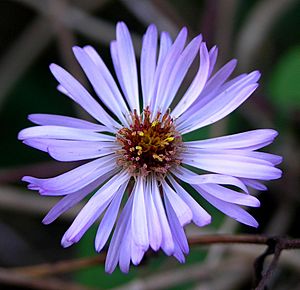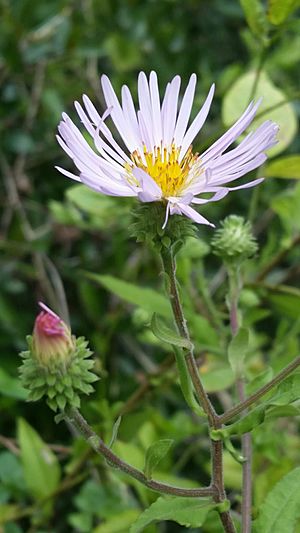Ampelaster facts for kids
Quick facts for kids Ampelaster |
|
|---|---|
 |
|
| Scientific classification | |
| Kingdom: | |
| (unranked): | |
| (unranked): | |
| (unranked): | |
| Order: | |
| Family: | |
| Tribe: |
Astereae
|
| Genus: |
Ampelaster
G.L.Nesom
|
| Species: |
A. carolinianus
|
| Binomial name | |
| Ampelaster carolinianus (Walter) G.L.Nesom
|
|
| Synonyms | |
|
Synonymy
synonyms of genus name
Aster Linnaeus sect. Sagittiferi A. Gray Aster sect. Caroliniani Small Lasallea Greene subsect. Carolinianae (Small) Semple & Brouillet Virgulus Rafinesque sect. Sagittiferi (A. Gray) Reveal & Keener synonyms of species name Aster carolinianus Walter Aster scandens J.Jacq. ex Spreng. Lasallea caroliniana (Walter) Semple & Brouillet Symphyotrichum carolinianum (Walter) Wunderlin & B.F.Hansen Virgulus carolinianus (Walter) Reveal & Keener Sitilias caroliniana (Walter) Raf. |
|
Ampelaster is a type of flowering plant found in North America. It belongs to the daisy family, which is a big group of plants that includes sunflowers and dandelions!
There's only one known type of Ampelaster, called Ampelaster carolinianus. People often call it the climbing aster. You can find it growing naturally in the southeastern United States, in states like Florida, Georgia, South Carolina, and North Carolina.
Contents
What Makes Climbing Aster Special?
The climbing aster is quite unique among plants in the daisy family. Most daisies grow upright, but this plant is a climber! It uses other plants, like trees or shrubs, to help it grow tall and reach sunlight.
How Does It Climb?
Sometimes, the climbing aster uses special roots called adventitious roots to help it climb. These roots grow from unusual places on the plant, like its stem, and help it cling to surfaces. This allows the plant to grow upwards without needing a strong, thick stem of its own.
What Do Its Flowers Look Like?
The climbing aster produces beautiful flower heads. These flower heads are usually found in groups of 1 to 15 on each branch. Each flower head has two kinds of tiny flowers:
- Ray florets: These are the petal-like parts that you see around the edge of the flower head. They are usually pale pink to rose-purple in color.
- Disc florets: These are the small, tightly packed flowers in the center of the flower head.
These pretty flowers make the climbing aster a lovely sight in the areas where it grows.
See also
 In Spanish: Ampelaster para niños
In Spanish: Ampelaster para niños


